
Developed primarily as an
export car for the US market, the 1800
was the last ever car to come with a folding “dickey”
seat...
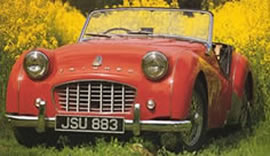
The TR1 was a disaster,
thankfully the designers were able
to create the wonderful TR2 the following
year...

Triumph used the Herald
as donor car for the Spitfire, including
the engine and transmission...
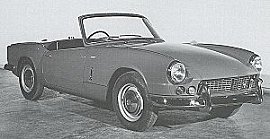
The very first Triumph
Spitfire prototype was affectionately
codenamed the "bomb"...
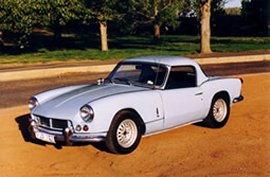
In total some 314,342 Spitfires
were built over an 18 year period – each
model consistently out-selling
the Sprite and Midget competition...
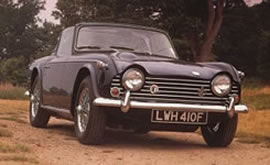
The new TR4 was revealed at Earls
Court in 1961, and featured far
superior creature comforts over
the previous models, such as wind-up
door windows...
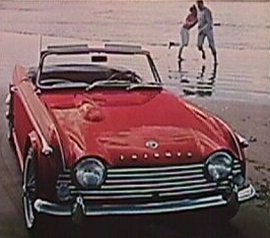
The TR4A's rear end was borrowed
from the Triumph 2000 sedan - providing
a more supple ride but dulling
the sporting characteristics of
the car. US buyers were therefore
offered an optional rigid rear
axle...
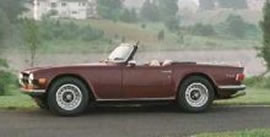
While many bemoaned the fact that
the new TR6 was mechanically identical
to its predecessors, few could
resist the flowing lines derived
from West German designers Karmann...
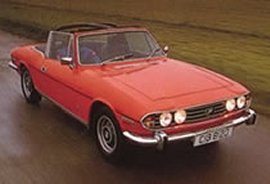
The TR8 may have only been sold
in the US, but Australian and European
buyers could get their hands on
the wonderful V8 Stag...
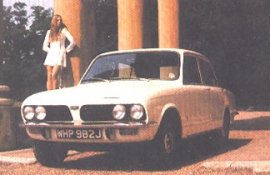
Considered by many to be the best
Triumph sedan ever built, the Dolomite
Sprint was launched after Triumph
were swallowed up by British Leyland...

In 1975 Triumph released the TR7,
undoubtedly the most controversial
of all the TR’s and regrettably
the last incarnation... |
You don’t have to look far to
find numerous car companies that have made the successful
transition from motorcycle to car manufacturer. Japanese
companies such as Honda and Suzuki immediately spring
to mind, but the undisputed pioneer in making such
a transition is Triumph.
The first Triumph car was announced in 1923, although
it would take until the 1930’s for the company
to develop cars of a more sporting nature. Strangely
the company choose the name “Southern Cross”
for the car, although we are unable to establish any
Australian connection.
Using a conventional chassis,
the Southern Cross was fitted with a Coventry-Climax
four cylinder 1018cc engine having overhead inlet and
side exhaust valves, this engine soon being upgraded
to 1122cc. A new generation Southern Cross was released in 1934;
the new model used a more advanced chassis and was fitted
with either a 1232cc four cylinder engine or 1991cc
six. But the most notable of the pre-war Triumphs was
the stellar 8 cylinder “Dolomite”, although
only 3 would be built in 1934/35.
Based on the Alfa
Romeo 8C2300 model, the Triumph was near identical to
the Alfa mechanically and, with supercharger, the 1990cc
engine was good for 140bhp.
But like so many automobile manufacturers the period
between wars proved extremely difficult financially,
and the Dolomite was soon shelved. In 1939 as the world
held its collective breath hoping Chamberlains peace
mission would be successful, Triumph would declare bankruptcy.
The Standard Car Co. purchased Triumph in 1944, and
in 1946 released the first Standard-Triumph, the “1800
Roadster”. After the war much of British industry
had seen the necessity to enter the lucrative US market
simply as a means of survival.
And so the 1800 was developed
primarily as an export car. The 1800 had three-abreast
seating, a steering column gear-change and, from what
we can determine, was the last ever car to come with
a folding “dickey” seat.
Standard used the
same 65bhp 1778cc engine for 1800 as they were supplying
to Jaguar for their 1.5 litre models. In 1948 they swapped
this unit for the Vanguards 2088cc 68bhp engine, and
re-named the car the “2000 Roadster”.
The management at Standard-Triumph was very astute,
watching and learning as other British manufacturers
enjoyed export success - it seemed the US had a predilection
for British made sports cars! But although the market
was sizeable, going head to head with more established
players such as MG and Jaguar seemed illogical.
The
1250cc MG TD was very popular at the lower end of the
market, while the 3442cc Jaguar XK120 enjoyed success
at the other. Standard-Triumph’s answer was to
build something in the middle ground, with a price and
engine capacity to match.
Using a modified Vanguard engine and gearbox, the prototype TR1 was first shown to the public at the 1952 London
Motor Show, but auto commentators soon revealed several
weaknesses in the car, not the least of which was poor
road-holding and performance! . The designers went to
work on a major makeover of the car, their aim being
to have a new version TR2 available and on sale for
the summer of 1953.
While the original TR1 used a modified Standard Flying
Nine frame and 75bhp engine and had an exposed spare
wheel on the tail, the new TR2 had its own special frame
featuring coil spring independent front suspension and
an engine specially tuned to develop 90bhp.
Styling
changes included a now longer and more elegant tail.
Its reputation was founded on competition success, and
right from the start of development the car achieved
124mph (199.5kmh) on the Jabbeke autoroute in May 1953.
The TR3 was introduced in October 1955, modifications
including a front grille in the air intake and a 95bhp
engine. As already developed for the TR2, overdrive,
wire wheels and a hardtop were optional extras. A year
later the TR3 broke new ground by becoming the first
series production British car to have Girling disk brakes on the front wheels.
Then in January 1958, came the
final style change for the body shape; the TR3A now
featured a full-width front grille and 100bhp engine,
and a 2138cc engine was on the options list for 1959.
For their all new model Triumph enlisted the services
of stylist Michelotti. The new TR4 was revealed at Earls
Court in 1961, and featured far superior creature comforts
over the previous models, such as wind-up door windows
and better interior appointments.
The chassis and running
gear was modified from the TR3A, however the wheel tracks
were now wider and the 2138cc engine became standard.
The TR4 was good for a top speed of around 109mph (175.4
kmh) and could do the 0-60mph dash in just under 11
seconds.
In 1965 came the TR4A, using a new chassis frame and
incorporating coil spring independent rear suspension.
The 2138cc engine was carried over from the previous
model, and the rear end was in much the same layout
as used in the Triumph 2000 sedan.
This latter modification
made the ride far more supple, but perhaps dulled some
of the sporting characteristics of the car. Worried
of a backlash in the US, American purchasers were offered
the option of ordering a TR4A with a rigid rear axle
as an alternative.
Externally the TR4A was nearly identical to the TR4.
To identify one, look for smaller indicator lights at
the front of chrome strips along the flanks and a revised
grille. The TR4A’s engine was good for 140bhp
and a top speed of almost 110mph (177 kmh).
Next came the 1967 TR5 – the big news being the
introduction of an all new fuel injected 2498cc six
cylinder engine (having evolved from the Triumph 2000
sedan). The new model still used the same basic chassis,
suspension and body shell as the outgoing TR4A, but
now offered true sports-car performance.
What a shame
then that the engine, being good for 150bhp in Europe,
would require the fitment of carburettors and anti-emission
controls for US exports and, in the process, loose a
whopping 45bhp! Provided you didn’t have a US
version you could now travel the autobahns at a lazy
120mph (193 kmh).
As is so often the way with the make-over afforded
a car during it’s lifespan, the TR’s were
gradually becoming larger, faster and more sophisticated
– changes necessary to maintain consumer interest
in the model. But this left Triumph without a cheaper
entry level sports-car, and knowing the importance of
this sector they set about designing an entirely new
but smaller sports-car.
The resulting “Spitfire”
had a unique steel backbone-type chassis frame and a
Michelotti-styled two-seater body style. Triumph relied
heavily on raiding the parts bin of the Herald as a
way of keeping costs and therefore the price down, and
so many items including the engine and transmission
were used.
The Spitfire featured all-independent suspension,
and quickly established itself as a direct competitor
with BMC's Sprite/Midget models. The first Spitfires used an 1147cc 4 cylinder engine
good for 63bhp and a top speed of 90mph (145 kmh). But
the car was somewhat utilitarian, and US consumers were
demanding of more comfort.
Triumph quickly established
an options list that would include overdrive, wire wheels
and detachable hardtop to name a few. In the spring
of 1965 the Mk 2 Spitfire was launched – the engine
was now good for 67bhp; this was followed in 1967 by
the release of the Mk 3 that came with a1296cc 75bhp
engine and close to 100mph top speed.
At the end of 1970 the Mk IV Spitfire was released.
The new model incorporated a rather more radical “swing-spring”
type of rear suspension – which resulted in greatly
improved road holding. Changes were not confined to
the suspension however, the restyled body shell now
including a cut-off tail and a more angular optional
hardtop.
The final derivative, produced from late 1974
to 1980, used a 1493cc engine which afforded a genuine
and undisputable 100mph top speed in European tune.
In total some 314,342 Spitfires were built over an 18
year period – each model consistently out-selling
the Sprite and Midget competition.
The GT6, first seen in 1966, was essentially a Spitfire
structure, modified with a smart fastback/hatchback
top and fitted with a 1998cc six-cylinder engine of
Triumph 2000 type, closely related to that of the TR5/
TR250. Many people compared it to a scaled down jaguar
E-Type.
With 95bhp on tap it was good for over 100mph
– it is unfortunate that the cars road-holding
did not match its performance! The Mk. 2 of 1968 was
a much improved machine, with 104bhp and a revised rear
suspension incorporating wishbone linkage.
The Mk 3
was introduced in 1970 and, like the Spitfire Mk IV,
featured a restyled body most notable for its cut off
tail. Finally, for 1973, the GT6 reverted to the “swing-spring”
rear suspension, but that was dropped by the end of
the year. A total of 40,926 GT6s were manufactured.
After just 2947 TR5’s and 8484 TR250’s
(US only) had been produced, these models were superseded
by the beautifully styled TR6. Many bemoaned the fact
that the new TR was mechanically identical to its predecessors,
but few could resist the flowing lines derived from
West German designers Karmann.
In fact the car used
the same basic body shell as the previous model, Karmann
given the brief to simply modernize the front and rear
of the car. By 1976 a total of 94,619 TR6’s had
been built, with only very minor cosmetic changes ever
being made to the original Karmann design.
In 1975 Triumph released the TR7, undoubtedly the most
controversial of all the TR’s and regrettably
the last incarnation. Breaking with tradition, the TR7
used a unit construction body/chassis structure and
- for the first four years - was only sold in notchback
two-seater coupe style.
The wedge-nose style featured
concealed headlamps, yet another brake from TR tradition.
It used a 1998cc SOC four cylinder engine borrowed (and
slightly modified) from the Dolomite sedan. The independent
front suspension was by MacPherson strut, but there
was rigid rear axle on coil springs with radius arm
location.
The new TR was smaller, but heralded great improvements
in comfort, handling, road-holding and economy. Initially
fitted with a four-speed all-synchro gearbox, in 1976
you could option an auto transmission - the first time
ever on a TR! A more robust five-speed gearbox soon
replaced the aging 4 speed, this unit being borrowed
from the new and much larger Rover hatchbacks and Series
III Jaguars.
The TR7’s engine was good for 105b
and a top speed of 109mph (175.4 kmh), perhaps not the
last word in performance but with fuel consumption figures
approached 29mpg not too many were complaining.
From 1978 BMC started rallying a Rover 3528cc V8 engined
version of the car, naturally enough called the “TR7
V8”, however the true TR8 production car was only
ever sold in the US in 1980/81. In 1979 a convertible
joined the existing TR7 coupe, while other versions
included a 16-valve 'Sprint' derivative.
But in 1977 a protracted strike by the Liverpool factory
workers would all but kill off the car. The management
switched production to Coventry, and then finally to
the Rover plant at Solihull, but the car was always
dogged by controversy, a poor quality reputation, and
finally by adverse currency movements between the British
pound and the US dollar. Production ended in October
1981, after 86,784 TR7 coupes, 24,864 TR7 drop-heads
and a mere 2,815 TR8s had been built. |



